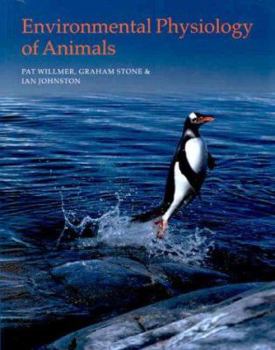Environmental Physiology of Animals
Select Format
Select Condition 
Book Overview
The new and updated edition of this accessible text provides a comprehensive overview of the comparative physiology of animals within an environmental context. Includes two brand new chapters on... This description may be from another edition of this product.
Format:Paperback
Language:English
ISBN:063203517X
ISBN13:9780632035175
Release Date:February 2000
Publisher:Wiley-Blackwell
Length:644 Pages
Weight:4.15 lbs.
Customer Reviews
2 ratings
VERY HIGHLY RECOMMENDED
Published by Thriftbooks.com User , 18 years ago
Are you working in the area physiological functioning and the comparative adaptations of animals? If you are, this book is for you. Authors Pat Willmer, Graham Stone and Ian A. Johnston, have written an outstanding book that integrates animal physiology into a more holistic approach. Willmer, Stone and Johnston, begin by considering adaptation in relation to selection on phenotypes, as determined by genes and their constituent DNA. Then, they cover the process of adaptation in a suitable molecular context, so that new information on the molecular interactions and genomic changes underlying ecophysiological modification can be easily assimilated as it becomes available. The authors continue by discussing the problems of size and scale. In addition, they also present the mechanisms for keeping volumes and concentrations of biological solutions under control--thus, keeping animal tissues operative, in the face of this fundamental challenge. The authors also examine the problem of animal water balance in terms of the actions , and control, of particular effector organs. Then, the authors discuss metabolism and energy supply. Next, they look at the fundamental design of respiratory systems whereby aerobically respiring animals take up the oxygen they require. Then, the authors review the effects of temperature on animals, and the kinds of adaptation they show to withstand or to counter temperature change. Next, they examine the basic functioning of excitable tissues, and how they permit detection of environmental change, response to it, and indeed learning about it. The authors continue by examining the properties and roles of hormones, especially in relation to the bigger issues of coping with environmental challenges, dealing first with the endocrine systems and component glands in different kinds of animals, then with the various functions that are regulated by specific hormones. In addition, they also examine marine life in general. The authors also discuss seashores and estuaries. Then, the authors discuss the nature and occurrence of fresh water. Next, they cover a range of "aquatic" habitats that are in various ways not strictly within the definitions of marine, littoral, estuarine, or freshwater habitats. Then, the authors cover the essential strategies of the broad range of animals that live in the majority of terrestrial habitats; particularly, in the temperate zones and the humid tropics, where thermal extremes are rarely encountered, and where water balance, though difficult to achieve, is not pushed to the limits for survival. Next, they deal with some special cases of terrestrial life: hot and arid deserts, where the hygrothermal endurance limits of animal residents may be severely tested; polar regions, tundra, and northern coniferous forests, where extreme cold is superimposed on the generality of terrestrial problems; and, montane habitats, where altitude effects may parallel the latitudinal effects at the poles. Finally, the author
A great journey into the physiology of animals in different habitats
Published by Thriftbooks.com User , 18 years ago
This text takes the unique approach of looking at the physiology of animals found in different environments. E.g. one may be interested in the adaptations found in deep sea animals or in intertidal organisms? It is an excellent text with plenty of information to allow one to get a better understanding of the array of physiological adaptations needed. It is also interesting to see how different types of animals have solved the same physiological problem. Overall, it is fascinating reading! Highly recommended. It would be useful for a prospective reader to have some previous knowledge of zoology and physiology before taking on this book.




